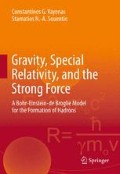Abstract
Is the strong force simply relativistic gravity? The very good, semiquantitative agreement shown in Table 1.1 and in Chaps. 7–10 between experiment and the Bohr-type rotating neutrino model described in Chap. 6 and summarized in Table 1.1 or 7.1 provides strong support to a positive answer. This is of course at the beginning quite counterintuitive since we have always been taught that strong force and gravity are the strongest and weakest forces, respectively, in nature. Their coupling constants differ by some forty to sixty orders of magnitude, and it is generally but rather vaguely anticipated that these coupling constants will merge, together with the electrostatic coupling constant, at distances of the order of the Planck length (∼10−35 m) and energies of the order of the Planck mass energy (∼1019 GeV ). A quantitative examination of the coupling constant behavior of relativistic gravity, assisted by the rotating neutrino hadron model, may thus provide useful and perhaps conclusive information.
Access this chapter
Tax calculation will be finalised at checkout
Purchases are for personal use only
References
Griffiths D (2008) Introduction to elementary particles, 2nd edn. Wiley-VCH Verlag GmbH & Co. KgaA, Weinheim
Povh B, Rith K, Scholz Ch, Zetsche F (2006) Particles and nuclei: an introduction to the physical concepts, 5th edn. Springer, Berlin, Heidelberg
Cottingham WN, Greenwood DA (2001) An introduction to nuclear physics, 2nd edn. Cambridge University Press, Cambridge
Wilczek FA (2004) Asymptotic freedom: from paradox to paradigm. The Nobel Prize in Physics. (http://nobelprize.org/physics/laureates/2004/publi.html)
Ahluwalia DV (1999) Testing time for theories. Nature 398:199–200
Brumfiel G (2011) Beautiful theory collides with smashing particle data. Nature 471:13–14
Weinberg S (1993) Dreams of a final theory: the search for the fundamental laws of nature. Cox & Wyman, London. ISBN 0-09-922391-0
Wheeler JA (1955) Phys Rev 97(2):511–536
Misner CW, Thorne KS, Zurek WH (2009) John Wheeler, relativity, and quantum information. Phys Today 62(4):40–46
Hehl FH, Šijački Dj (1980) Towards a unified gauge theory of gravitational and strong interactions. Gen Relativ Grav 12(1):83–90
Recami E, Zanchin VT (1994) The strong coupling constant: its theoretical derivation from a geometric approach to hadron structure. Found Phys Lett 7:85–93
Sivaram C, Sinha K (1977) Strong gravity, black holes, and hadrons. Phys Rev D 16(6), 1975–1978; references therein
Hadley MJ (2007) Classical dark matter. arXiv:gr-qc/0701100v1
Author information
Authors and Affiliations
Rights and permissions
Copyright information
© 2012 Springer Science+Business Media, LLC
About this chapter
Cite this chapter
Vayenas, C.G., Souentie, S.NA. (2012). Force Unification: Is the Strong Force Simply Gravity?. In: Gravity, Special Relativity, and the Strong Force. Springer, Boston, MA. https://doi.org/10.1007/978-1-4614-3936-3_12
Download citation
DOI: https://doi.org/10.1007/978-1-4614-3936-3_12
Published:
Publisher Name: Springer, Boston, MA
Print ISBN: 978-1-4614-3935-6
Online ISBN: 978-1-4614-3936-3
eBook Packages: Chemistry and Materials ScienceChemistry and Material Science (R0)

